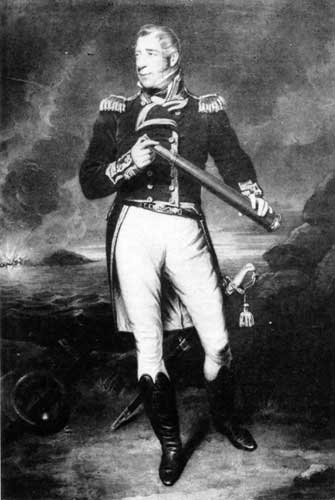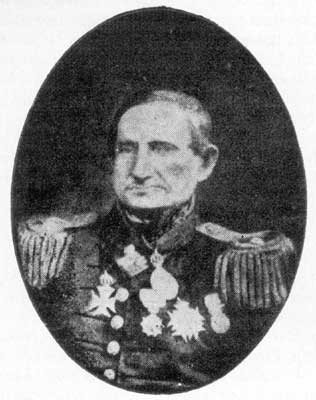|

Lord Cochrane, First Admiral of Brazil
(From the mezzotint by Meyer showing him in his prime
in 1810) |
The abrupt change in the navy's role dealt a blow to its
personnel. Promotion was frozen and foreign officers who had
not fought actively in the War of Independence were
discharged. Nevertheless, the Navy List of 1835 still
contained the names of twenty-two English, Scottish and Irish
veterans, a number of whom stayed on in
Brazil
to attain the highest ranks in the service.
[19] Of the
remaining thirty-nine who had been recruited during 1823-5,
seventeen had resigned or returned home at the end of their
five-year contracts, nine had died or been killed in action,
two had become invalids, five had deserted and six had been
dismissed for incompetence, frequently the result of excessive
drinking. A further twelve junior lieutenants had been
recruited specifically for the Argentine war and were
discharged immediately afterwards. Their fates are unknown.
Economies may have been made but the navy was still necessary.
The simmering regionalism of Brazil and growing economic
hardship resulted in a spate of colourfully named rebellions:
the 'Cabanos' in Pernambuco 1832‑1835 and in Pará 1835‑1836;
the 'Sabinada' in Bahia in 1837‑1838; the 'Balaiada' in
Maranhão in 1839‑1840; and the 'Farrapos' in Rio Grande do Sul
and Santa Catarina which dragged on for a decade from 1835.
These crises caused a partial mobilisation of forces. In 1836,
the number of ships in commission was increased to thirty, but
a rapid expansion in manpower proved as difficult to achieve
as it had been in 1823. This time, the government mounted a
recruiting campaign in the Orkneys and Shetland Islands.
The Brazilian Navy was prominent in the suppression of all of
these outbreaks, as were its remaining British officers.
Captain William James Inglis and Lieutenant Richard Norbert
Murphy were killed during the bloody 'Cabanos' rebellion in
Pará. Commodore John Taylor led the force which restored
order, assisted by Captains William Eyre, George Manson and
Bartholomew Hayden. In the south, it was Commodore John Pascoe
Grenfell who suppressed the 'Farrapos' rebellion, with
Captains William Parker, Richard Hayden and George Broom under
his command.
Reflections
How can one analyse the contributions of these officers who
fought for the Independence of Brazil? In the literal sense
they were mercenaries, but that word acquired distasteful
associations in the twentieth century and is best avoided.
These men simply sought to earn a living. Since the
Revolutionary and Napoleonic Wars had lasted for a generation,
there were plenty of people in Europe who knew of no other
occupation or had no other expectations.
As individuals they were certainly a mixed group. Some
successfully completed their five-year contracts and returned
to
Europe.
Others died in action or of the diseases that were endemic on
overcrowded ships in the tropics, and never saw their
homelands again. Some were heroes whose achievements are
remembered to this day. Others - to quote Brazilian Admiral
Tamandaré's reflections in old age - 'were immensely brave but
not very bright.' Some had dubious careers due to drink or
incompetence and were quietly retired, while others, though
relatively few, were dazzlingly successful as leaders, married
locally and stayed on in Brazil to reach the highest ranks in
the Imperial Navy. Some officers merged into Brazilian
society, but the majority did not come as long-term migrants
but as short-term employees with professional skills to sell.
This was quite unlike the navy of Buenos Aires, for example,
whose officers were immigrants who happened to have naval
experience.
|

Cochrane's Flag Captain, Thomas Sackville
Crosbie,
in Brazilian Uniform. |
Another point which also emerges is that whereas the
revolutionary squadrons of Chile and Argentina attracted
officers from a number of national backgrounds, notably North
American, the Brazilian Navy was dominated by officers of
English, Scottish and Irish origins. A possible reason for
this is that whereas subjects of King George may have been at
ease with the monarchical trappings of Brazil and were happy
to become subjects of the Emperor Pedro, Americans preferred
to serve in the more familiar atmosphere of republican
regimes.
What is also clear is that victory at sea was vital in
securing Brazilian independence and that the reliability,
leadership and technical skills of officers recruited by the
navy from
England,
Scotland and Ireland were crucial to that success. The
decisive effect of Lord Cochrane's incomparable military
talents is obvious, yet the presence of the officers who
supported him was no less significant, bringing with them
professionalism, an aggressive approach and a confidence in
victory born of years of unquestioned supremacy at sea. They
may not have had the social impact on Brazil of large groups
of immigrants, but in qualitative terms their contribution to
the country’s independence and survival was immense.
From documents scattered in the Brazilian archives, it is
possible to piece together the careers of those of British and Irish
origin among these men in South America. A great deal is known
about the seven who achieved the rank of commodore or admiral,
including their births, marriages and deaths. However, there
are few records in
Brazil
about the origins, nationalities or pre-independence careers
of the bulk of the others. Likewise, while it is possible to
find some records showing previous service in the Royal Navy,
the Admiralty only kept central records for Lieutenants and
superior ranks, rendering it impossible to trace the legions
of Midshipmen and Master’s Mates whose names are scattered in
the muster rolls of a thousand ships. Neither is O’Byrne’s
usually invaluable 1849 Biographical Dictionary of all
living officers of the Royal Navy helpful. Entries were
written by the individual concerned who, unless they had
aristocratic or fashionable connections, tended to say nothing
of their origins, apart, of course, for the most flamboyant or
self confident. Captain Donat Henchy O’Brien’s extensive
entry, for example, begins with ‘descended from one of the
ancient monarchs of Ireland,…’ while that of Thomas Sackville
Crosbie says nothing of his family or place of origin. It is
only Maria Graham’s description of him as ‘a young,
gentleman-like Irishman’ that provides a clue.
|

Bartholomew Hayden in old age wearing the
uniform of a
Brazilian Commodore. |
Neither is anecdotal evidence of nationality easily found in
South
America. Generally speaking, South Americans did not
distinguish between Englishmen, Scotsmen and Irishmen,
classifying them all as ‘ingleses’. Indeed the men themselves
also seemed uninterested in these distinctions and seemed
happy to refer to themselves as both ‘inglés’ and
‘Englishman.’ When discussing the impact of his campaigns on
trade with officers of the Royal Navy, the Scotsman Cochrane
frequently reminded them that ‘he was conscious of his duty as
an Englishman’. [20] It is no surprise that Woodbine Parish,
His Majesty’s Consul-General and an Englishman, should remark
as he surveyed the diverse Brazilian squadron in the River
Plate, that ‘it appears so formidable to the Buenos Aireans
because it is largely commanded and manned by Englishmen.’
[21] It was a Scotsman, Robert Gordon, who wrote a furious
dispatch from the British Embassy in Rio complaining that the
Brazilian-Argentine War, rather then being a conflict between
the nationals of two foreign states, was actually ‘a War
Betwixt Englishmen.’ [22] What he meant was a war between
English, Irish and Scottish subjects of King George. His
colleague in Buenos Aires, the Irish peer Lord Ponsonby, was a
little more accurate, portentously ending a dispatch by
describing the glorious engagement of Brown’s Argentine
flotilla by Norton’s Brazilian squadron at the Battle of Monte
Santiago with the words ‘You will observe that all these
splendid displays of courage have been made by Britons!’
[23]
Brian Vale
Notes
[1] Decree of 21 March 1823, reproduced in Theotonio Meirelles
da Silva, Apontamentos para a Historia da Marina de Guerra
Brazileira (Rio de Janeiro, 1882) Vol. 2, 67.
[2] Brant’s dispatches reproduced in Publicações do Archivo
Nacional,
Rio,
Vol. VII, 1907.
[3] Brant to José Bonifácio, 4 January 1823, Publicações.
[4] Brant to José Bonifácio, 12 January 1823, with appendices,
Publicações. Also Francis Clare’s contract in the
Dundonald (Cochrane) Papers in the National Archives of
Scotland (NAS), GD 233/34/244.
[5] Decree of
23 August 1823, reproduced in Meirelles da Silva, Apontamentos,
69.
[6] Diario do Governo,
Rio, Maritime Notices,
24 March 1823.
[7] Reports of the Real Junta da Fazenda, 10 and
26 April 1823, Archivo Nacional (AN)
Rio, XM80.
[8] Maria Graham, Journal of a Voyage to
Brazil and Residence there during part of the Years 1821,
1822 and 1823, (London,
1824), 221.
[9] Reports of the Real Junta da Fazenda, AN XM80.
[10] Brant to José Bonifácio,
11 February 1823,
Publicações.
[11] Brant to José Bonifácio,
25 March 1823, Publicações.
Inevitably, the Brazilian Government refused to pay the
amounts promised by Meirelles, with the result that after the
campaign of independence the seamen began to desert in droves.
[12] Decree of 23 August 1823, reproduced in Meirelles da
Silva, Apontamentos, 69.
[13] At the beginning of 1825, of the 174 officers in the
Brazilian Navy List, 49 were British – one Admiral, five
Captains, nine Commanders and 34 Lieutenants and
Sub-lieutenants - all of whom were serving at sea.
[14] For the story of the campaigns see, Brian Vale,
Independence or Death! British Sailors and Brazilian
Independence 1822-5, (London,
1996).
[15] Brant and Gameiro to Carvalho e Mello,
5 November 1824,
reproduced in Archivo Diplomatico da Independencia, (Rio, 1922), Vol. 2. Only one frigate was purchased in
London – a converted East Indiaman called the
Surat
Castle
– but two armed steamships were purchased in
Liverpool.
Originally called Britannia and
Hibernia,
they were renamed Correio Brasileiro and Correio
Imperial and reached Brazil in 1826. In what is probably
the first recorded action between sail and steam, the first
found herself in action against the Argentine privateer
Congreso off
Rio de Janeiro
in September 1827 and was disabled by a shot in her paddle
wheels.
[16] Gameiro to Vilella Barbosa, 7 May, 27 June, 9
July,
19 December 1815,
reproduced in Archivo Diplomatico.
[17] For an analysis of the war see, Vale,
'A War Betwixt Englishmen’,
Brazil versus
Argentina
in the River Plate 1825-30,
(London, 2000).
[18] Relatório da Repartição dos Negócios da Marinha.
(Rio,
1828), Bibliotéca
Nacional,
Rio.
[19] See Almanack da Marinha 1835, Bibliotéca da
Marinha,
Rio.
[20] Captain Hickey to Commodore Bowles,
24 May 1819,
Public Records Office (PRO),
Kew, Ad 1/1563.
[21] Parish to Canning,
20 July 1825,
PRO Kew, FO 6/9.
[22] Gordon to Dudley,
1 October
1827, PRO Kew, FO 13/39.
[23] Ponsonby to Canning,
20 April
1827, PRO Kew, FO 6/17
References
- Archivo Diplomático da Independência. (Rio de Janeiro:
Ministério de Relações Exteriores, 1922). Vol. 2,
Correspondence with Brazilian mission in
London.
- Boiteux, Lucas, 'A Armada Brasileira Contraposta a Confederação do
Equador' in Subsídios para a História Maritima do Brasil,
Vol. 13 (Rio de Janeiro, 1957).
- Cavaliero, Roderick, The
Independence of
Brazil
(London, 1993).
- Graham, Mrs Maria, Journal of a Voyage to
Brazil and Residence there during part of the years 1821, 1822 and 1823
(London, 1824).
- História Naval Brasileira, Vol. 3, Issue
1, 1821-1828 (Rio
de Janeiro: Serviço de Documentação da Marinha,
2002).
- Manchester, Alan K, British Preeminence in
Brazil. Its Rise and Decline (Durham, NC, 1933).
- Meirelles da Silva, Apontamentos para a História da Marinha de
Guerra Brazileira (Rio de Janeiro, 1882), Vol. II.
- Navigator, 'A Marinha nas Lutas da Independência' (Rio de
Janeiro: Serviço de
Documentação da Marinha, December 1971).
- Publicações do Archívo Publico Nacional (Rio de Janeiro, 1907),
Vol. 7. Dispatches of Felisberto Brant Pontes from
London
1822‑1823.
- Vale,
Brian,
Independence or
Death! British Sailors and Brazilian Independence 1822-25,
(London 1996).
- Vale,
Brian, The Audacious Admiral Cochrane (London,
2005).
- Vale, Brian,
'A War Betwixt Englishmen’,
Brazil versus
Argentina
in the River Plate, 1825-30
(London, 2000). Translated into Spanish as Una Guerra Entre
Ingleses (Instituto de Publicaciones Navales,
Buenos Aires,
2005). |




